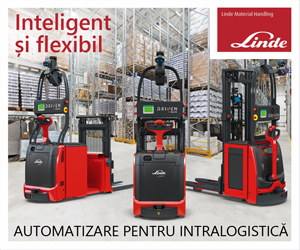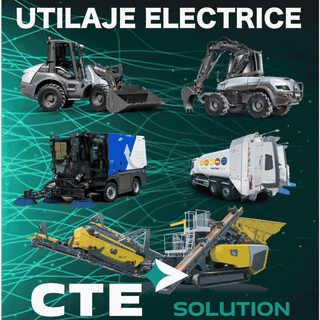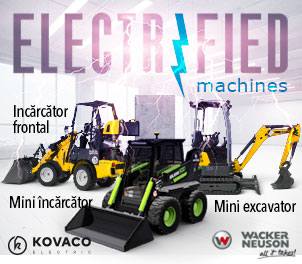Daimler Truck celebrates the European premiere of FUSOs Next Generation eCanter at IAA 2022
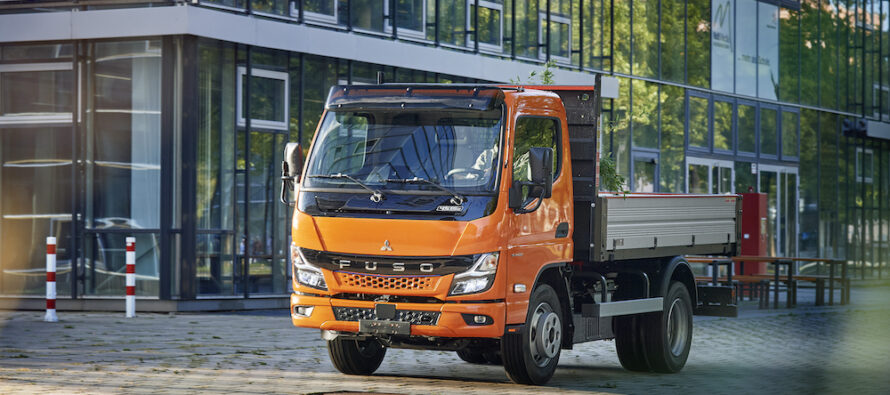
Story Highlights
- FUSO eCanter
- Daimler Truck
- camion distributie usoara
- IAA 2022
- e-Mobilitate
- camion electric
Related Articles
More powerful, more efficient, more range – and a wide variety of applications: This is the essence of the Next Generation eCanter from FUSO presented at the IAA Transportation 2022. Since the introduction of the eCanter in 2017, FUSO, the Japanese subsidiary of Daimler Truck, has been regarded as a pioneer and frontrunner in electric trucks and is consistently working on the implementation of sustainable, CO2-neutral transport solutions.
Currently there are more than 450 FUSO eCanter in daily customer operation in Europe, Japan and the United States, as well as in Australia and New Zealand. The total distance covered by the global eCanter fleet in all-electric and thus locally emission-free mode is now over six million kilometers – equivalent to about 150 circumnavigations of the globe. The Next Generation eCanter is now taking this success story to a new level.
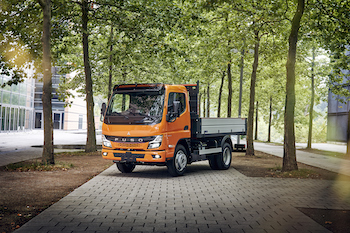 Ready for an, even more, ecological and economical operation
Ready for an, even more, ecological and economical operation
In order to meet customer requirements even more, FUSO has made several adjustments to the Next Generation eCanter. While the current electric truck was previously only available as a 7.49-tonner with a wheelbase of 3,400 millimeters, customers now have a choice of six wheelbases between 2,500 and 4,750 millimeters and a permissible gross vehicle weight of 4.25 to 8.55 tons. The load capacity of the chassis is up to 5 tons. The Next Generation eCanter is powered either by a 110 kW (variants with gross weights of 4.25 and 6 tons) or 129 kW (variants with gross weights of 7.49 and 8.55 tons) electric motor with an optimized driveline and 430 Nm of torque; the maximum speed is 89 km/h.
Depending on the wheelbase, three different battery packs are available: S, M, and L. The batteries use lithium iron phosphate (LFP) cell technology. These are characterized above all by a long service life and more usable energy. The battery pack in the S variant has a nominal capacity of 41 kWh and enables a range of up to 70 kilometers. In the M variant, the nominal capacity is 83 kWh and the range is up to 140 kilometers. The L variant, as the most powerful package, offers a nominal capacity of 124 kWh and a range of up to 200 kilometers. This is far more than the distance usually covered per day in light distribution traffic. Recuperation can increase the range even further, which at the same time minimizes charging breaks. By comparison: Until now, the eCanter only had a battery option with a nominal capacity of 81kWh and a range of up to 100 kilometers.
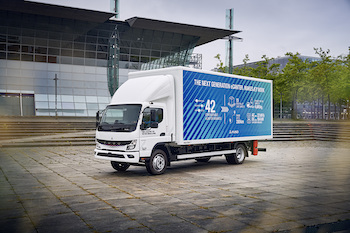 As far as battery charging is concerned, the Next Generation eCanter is compatible with all main voltages in the major markets. The charging unit supports charging with both alternating current (AC) and direct current (DC). The Combined Charging System CCS is the charging standard, and charging is possible with up to 104 kW. DC fast charging to 90 percent of capacity is possible in approximately 36 (S), 44 (M) and 75 minutes (L), depending on the battery pack. AC charging (11 and 22 kW) takes between four and six hours, depending on the battery pack.
As far as battery charging is concerned, the Next Generation eCanter is compatible with all main voltages in the major markets. The charging unit supports charging with both alternating current (AC) and direct current (DC). The Combined Charging System CCS is the charging standard, and charging is possible with up to 104 kW. DC fast charging to 90 percent of capacity is possible in approximately 36 (S), 44 (M) and 75 minutes (L), depending on the battery pack. AC charging (11 and 22 kW) takes between four and six hours, depending on the battery pack.
Competent advice for tailor-made e-mobility
As e-mobility is more than just a new drive, FUSO integrates the Next Generation eCanter into a business ecosystem that also includes tools and consulting services for high vehicle utilization and optimization of the Total Cost of Ownership. Through a special analysis of the total cost of ownership, FUSO dealers can offer each customer a completely individual calculation for operating the eCanter. With the help of the Daimler Truck Incentive Tool, it is also possible to get an overview of incentives and benefits such as specific government subsidies for vehicles or charging infrastructure as well as tax reductions or toll waivers. Through a strategic partnership with Siemens Smart Infrastructure and ENGIE, customers can also obtain comprehensive advice on the subject of DC charging infrastructure and receive a complete service package. From charging technology and installation to coordination with the network operator.
Versatile, comfortable, and safe
The Next Generation eCanter, which is available in two cab variants (Standard = 1.7 meters wide and Comfort = 2 meters wide), is characterized not only by its overall ecological and economic concept but also by its versatility. The electric truck from FUSO is compatible with many body applications, which makes it the ideal companion for a wide range of applications – whether for the delivery of general cargo over short distances and for e-commerce orders, for beverage and industrial gas transport, for towing services, refuse collection, the construction industry or horticulture.
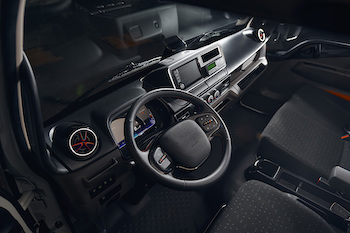 Numerous features and devices ensure a high level of comfort for the driver and road safety for all involved. Standard highlights include the multifunction steering wheel with buttons for controlling the fully digital LCD instrument cluster, LED headlights that are 30 percent brighter than halogen models for increased visibility, the Autolight function for controlling the headlights depending on lighting conditions, and Intelligent Highbeam Assist.
Numerous features and devices ensure a high level of comfort for the driver and road safety for all involved. Standard highlights include the multifunction steering wheel with buttons for controlling the fully digital LCD instrument cluster, LED headlights that are 30 percent brighter than halogen models for increased visibility, the Autolight function for controlling the headlights depending on lighting conditions, and Intelligent Highbeam Assist.
In terms of safety, the batteries are mounted under the vehicle’s chassis frame with a highly rigid steel bracket that also serves as impact protection for the battery in the event of a frontal or side crash. In the event of an accident, a crash sensor automatically deactivates the high-voltage system. For improved acoustic perception by pedestrians or cyclists, for example, the Next Generation eCanter is equipped with an external Acoustic Vehicle Alerting System (AVAS) as standard. For greater safety when turning right, Active Side Guard Assist is also fitted as standard. In addition, the fifth-generation Active Brake Assist with pedestrian detection, which is also standard, can reduce the risk of a collision in longitudinal traffic.


